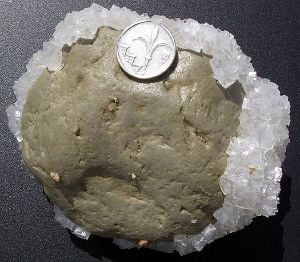Evaporite
In geology, evaporites are water-soluble, mineral sediments that result from the evaporation of restricted bodies of water on the Earth's surface. They are considered sedimentary rocks. Major evaporite minerals include halides (such as halite, sodium chloride), sulfates, nitrates, carbonates, and borates. These deposits are highly valued. For example, halites can form diapirs[1] (salt domes) where petroleum deposits can be trapped, and nitrates are important for the manufacture of fertilizers and explosives.
Formation of evaporite rocks
All bodies of water on the Earth's surface and in aquifers contain dissolved salts. To form minerals from these salts, the water must evaporate into the atmosphere, so that the minerals precipitate out. For this to happen, a water body must enter a restricted environment in which water input remains below the net rate of evaporation. This is usually an arid environment with a small basin fed by a limited input of water. When evaporation occurs, the remaining water is enriched in salts, which precipitate when their concentration in water becomes high enough that they can no longer remain in solution.
The less soluble a mineral is, the more readily it precipitates out of solution. The order of precipitation for several minerals is:
- Calcite (CaCO3) and dolomite (CaMg(CO3)2)
- Gypsum (CaSO4.2H2O) and anhydrite (CaSO4)
- Halite (also called common salt, NaCl)
- Potassium and magnesium salts
Most evaporite formations do not contain more than a few percent of evaporite minerals, the remainder being composed of the more typical detrital clastic rocks and carbonates.
For a formation to be recognized as evaporitic, it may simply require recognition of halite-like structures (pseudomorphs), sequences composed of some proportion of evaporite minerals, and recognition of mud crack textures or other textures.
Evaporites can also be recrystallized in laboratories. Scientists use this approach to determine the specific characteristics of formation of these minerals.
Environments where evaporite deposits are found
Evaporite deposits can be found in the following environments:
- Graben[2] areas and half-grabens within continental rift environments fed by limited riverine drainage, usually in subtropical or tropical environments. Examples of such environments are the Denakil Depression in Ethiopia and Death Valley in California.
- Graben environments in oceanic rift environments fed by limited oceanic input, leading to eventual isolation and evaporation. Examples include the Red Sea and the Dead Sea in Jordan.
- Internal drainage basins in arid to semi-arid temperate to tropical environments fed by ephemeral drainage. Example environments include the Simpson Desert in Western Australia and the Great Salt Lake in Utah.
- Non-basin areas fed exclusively by groundwater seepage from artesian waters. Examples include the seep-mounds of the Victoria Desert, fed by the Great Artesian Basin in Australia.
- Restricted coastal plains in regressive sea environments. Examples include the sabkha deposits of Iran, Saudi Arabia, and the Red Sea.
- Drainage basins feeding into extremely arid environments. Examples include the Chilean deserts, certain parts of the Sahara, and the Namib desert.
Major groups of evaporite minerals
- Halides: halite (NaCl), sylvite (KCl), and fluorite
- Sulfates: such as gypsum, barite, and anhydrite
- Nitrates: nitratite (soda niter) and niter
- Carbonates: such as trona, formed in inland brine lakes.
- Borates: a common example is borax (used in soaps as a surfactant), which is typically found in arid salt-lake deposits plentiful in the southwestern United States.
Economic importance of evaporites
Evaporites are important economically because of their mineralogy, their physical properties in-situ, and their behavior within the subsurface.
Evaporite minerals, especially nitrate minerals, are economically important in Peru and Chile. Nitrate minerals are often mined for the production of fertilizers and explosives.
Thick halite deposits are expected to become an important location for the disposal of nuclear waste because of their geologic stability, predictable engineering and physical behavior, and imperviousness to groundwater.
Halite formations are famous for their ability to form diapirs, which produce ideal locations for trapping petroleum deposits.
See also
Notes
- ↑ A diapir is a relatively mobile mass that intrudes into preexisting strata, usually by pushing its way upward through structural weaknesses in overlying rocks. Diapirs may include igneous structures, but the term is more commonly applied to non-igneous, relatively cold materials such as salt domes and mud structures.
- ↑ A graben (German word for "ditch") is a depressed block of land bordered by parallel faults.
ReferencesISBN links support NWE through referral fees
- Guéguen, Yves, and Victor Palciauskas. Introduction to the Physics of Rocks. Princeton, NJ: Princeton University Press, 1994. ISBN 0691034524.
- Gore, Rick. The Mediterranean: Sea of Man's Fate. National Geographic. (1982): 694-737.
- Skinner, Brian J., Stephen C. Porter, and Jeffrey Park. Dynamic Earth: An Introduction to Physical Geology. 5th ed. Hoboken, NJ: John Wiley, 2003. ISBN 0471152285
- Tucker, Maurice E. Sedimentary Petrology. 3rd ed. Oxford: Blackwell Publishing, 2001. ISBN 0632057351
Credits
New World Encyclopedia writers and editors rewrote and completed the Wikipedia article in accordance with New World Encyclopedia standards. This article abides by terms of the Creative Commons CC-by-sa 3.0 License (CC-by-sa), which may be used and disseminated with proper attribution. Credit is due under the terms of this license that can reference both the New World Encyclopedia contributors and the selfless volunteer contributors of the Wikimedia Foundation. To cite this article click here for a list of acceptable citing formats.The history of earlier contributions by wikipedians is accessible to researchers here:
The history of this article since it was imported to New World Encyclopedia:
Note: Some restrictions may apply to use of individual images which are separately licensed.
